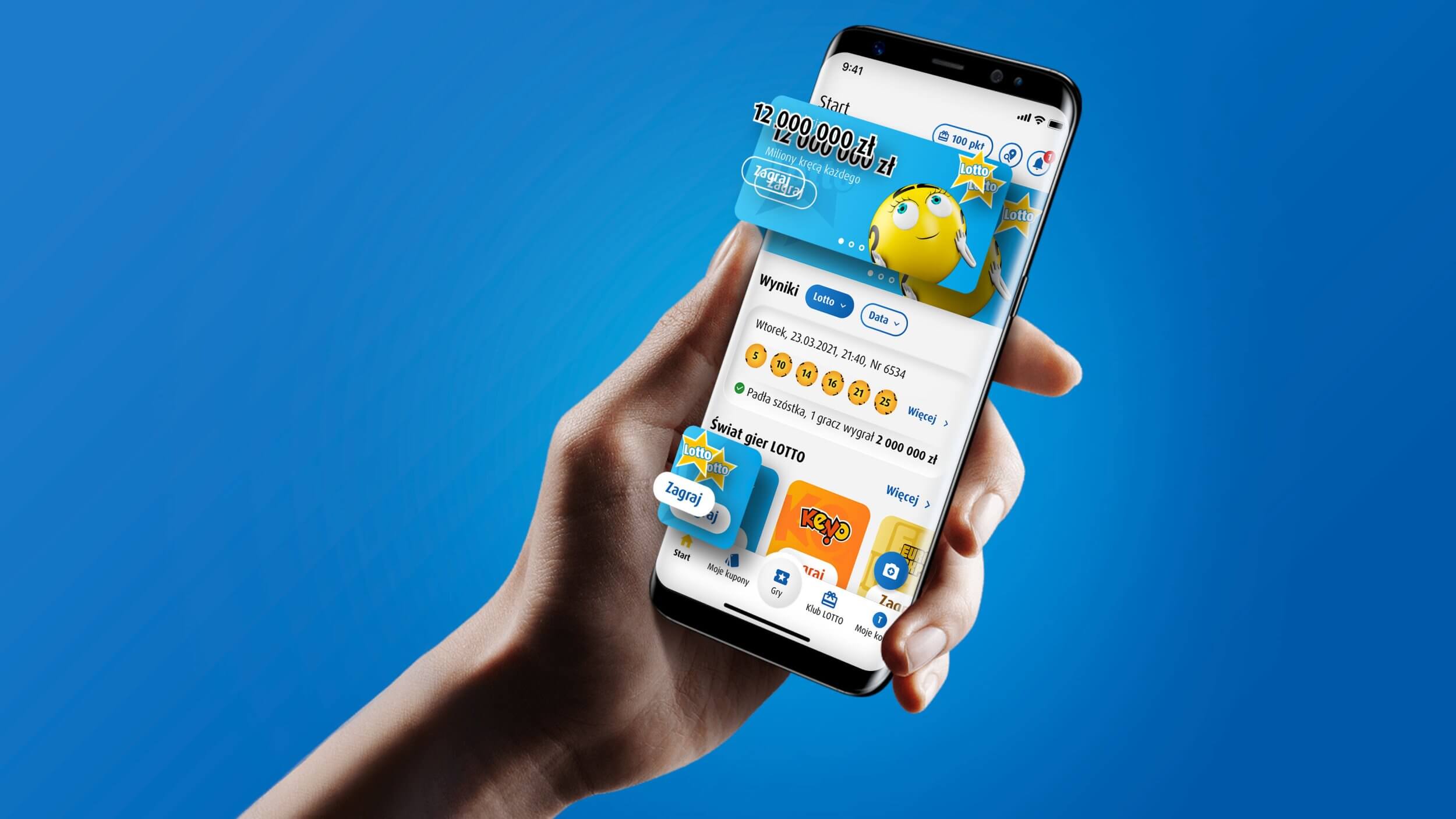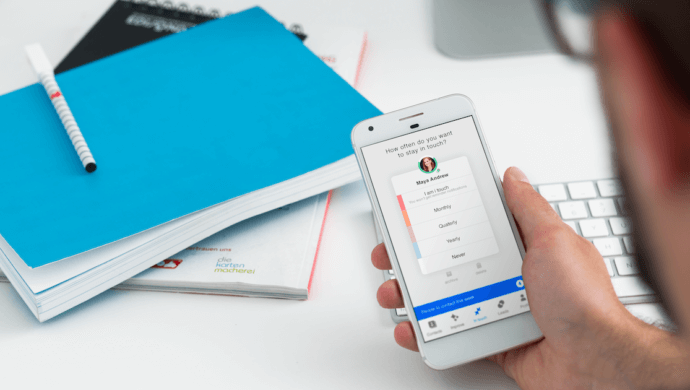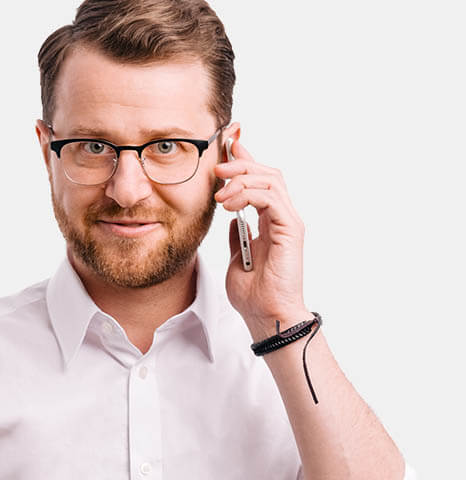I enjoy designing solutions for the lottery and entertainment industry. Such projects are a lot of fun due to the fact that they touch on situations and emotions that you can usually identify with in some parts. They can also be very surprising and turn everything you have previously known about the industry upside down. At the same time, they involve a lot of responsibility because of the social context and the scale of this type of business model. This is exactly what happened with the project carried out in cooperation with Totalizator Sportowy, owner of the LOTTO brand. Below you will find a few words of reflection on the course and implementation of one of our favourite projects from last year.
Demo
I remember the first association I had when joining the client team working on the new LOTTO app. It was a memory of my grandfather, who was a big fan of number games. I also remember the closely guarded notebook in which he wrote down every draw and his attempts to play with his system calculated on a piece of paper. You will admit that this is a bit of an analogue association. We are in the year 2022, where almost everything can be done online.
But do LOTTO players actually need a mobile app? Who still plays LOTTO at all, and online at that? While gamers are rather associated with young people, are LOTTO players only the older generation? Going further: why does a company like Totalizator Sportowy, being a monopolist in the market, want to create a new application and develop digital sales channels? And then the most important question (pardon the industry joke): should the Games and Betting Control Commission also find its place in the app?

The design process is about constantly asking questions and finding the best answer. The most important thing is to find a useful framework to translate the solutions developed into concrete actions. Find out our tried and tested ways.
Understand the rules of the game
Round 1: How do we reconcile the offline world with the online world?

- Will the impulse to play triggered by an in-app push message be as engaging as the ‘stumbling block’ informing of a big jackpot encountered by a customer walking past a LOTTO outlet?
- Does it make sense to reflect the coupon-clicking situation in the app and why?
- Why is the app only part of the customer’s journey through the world of LOTTO?
Knowing the needs and expectations of users is crucial to the success of any application. This is the sentence you will find in every sensible digital solution design framework. This is of course true. However, there are times when we are too quick to focus on the user in the design process. Of course, the user must be and is always the focus of the designer. I don’t mean artificially inventing customer needs. Rather, I am referring to the need to understand a company’s ecosystem and all the contexts in which it implements its business model.
This is particularly important in companies and organisations that have been in the market for a very long time, concerting for many years on the development of traditional sales channels. The transfer of knowledge between our teams about our customers and the company’s baggage of experience regarding the fixed sales network is essential for designing new digital tools that fit into the company’s operating ecosystem.
It was the reconciliation of the offline and online worlds that we found most challenging from the perspective of designing the LOTTO application. Working directly with the company’s department responsible for online sales, it was necessary to transfer knowledge from the entire organisation, especially to involve in the project those responsible for the so-called ‘ground sales’ and loyalty activities aimed at customers.

It was equally important to understand how the current online sales channels work. Totalizator Sportowy had already been developing a web service to play LOTTO online for many years. A mobile application was also available. We know from experience that decisions to redesign applications at such companies are not driven by the need of the moment. We considered understanding the business objectives and the context behind the decision to be key elements of the design process. This made it easier for us to implement the next stages of the project.
Useful artefacts: Business Centered Design (BCD) workshop – in the first stage of the design process, we conducted a creative workshop with a working team consisting of researchers, UX and UI designers, and representatives from Totalizator Sportowy. The purpose of the workshop was to map the company’s business ecosystem and transfer knowledge about customers and sales channels, as well as to understand the company’s business objectives and challenges in relation to the design of the new mobile app.
Meet the players
Round 2: How do we reconcile the needs of different players?
- What do players who choose different LOTTO games have in common?
- Do all LOTTO players dream of winning?
- Why do only some buy scratch cards?
- Experienced companies such as Totalizator Sportowy know their customers very well. They conduct regular market research and sales analyses.
Receiving the reports and analyses, we were very impressed by their insight and orderliness. Counter-intuitively, however, the characteristics of the user for whom we will be designing applications required a slightly different approach than that of a traditional customer.
Dealing with target groups and their purchase paths is effective in terms of achieving sales targets and marketing campaigns. When designing apps and digital products, humanising customer profiles work best. Imagining a specific person using the LOTTO app was key to designing the LOTTO game world. Especially since it is not a homogeneous world.
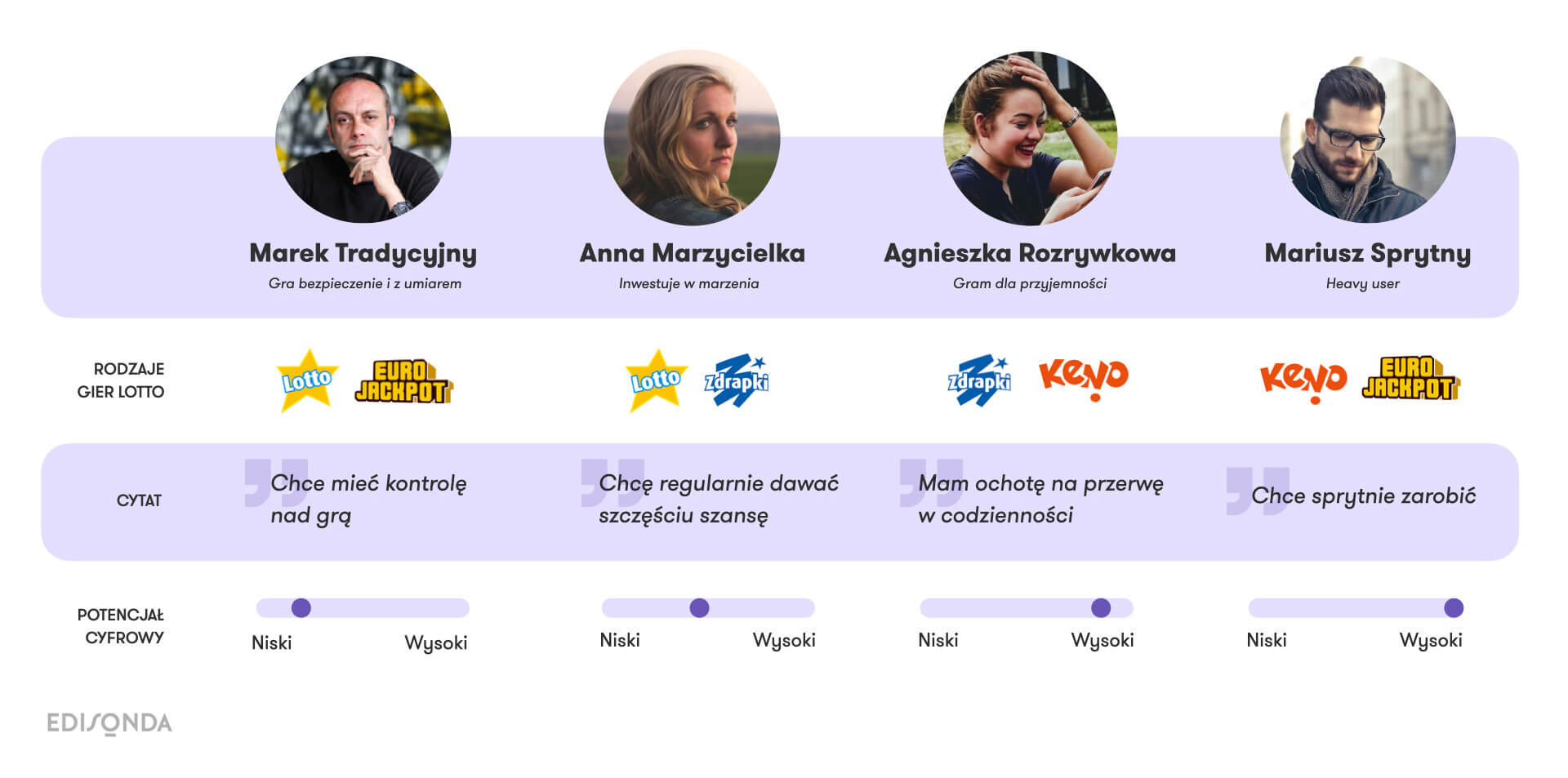
In characterising the Person of the players, we distinguished several basic types, i.e. the dreamer, the traditionalist, the entertainer, and the clever. I will not go into details about the characteristics of each type here. However, from the perspective of the design process, it is worth noting that these characteristics were crucial to the design of specific functionalities in the app. Creating Personas in digital projects is an unwritten standard. It is only effective if we ensure that this characterisation is as detailed as possible. It should cover the scope of all paths and points of contact (customer journey map) of the Persona with the company, not only with the app but with all the company’s sales channels.
Customer Persons accompanied us at every stage of the design process (from research, through design and guidelines for the implementation of the app).
Useful artefacts: User-Centered Design (UCD) workshop – a parallel element of the first phase of the design process was the creation of a Person and Customer Journey Map (CJM) and the definition of a unique value proposition (UVP) for the app in the context of the other sales channels and tools. We created the Personas during a creative workshop with the LOTTO team, using existing customer research, sales analysis, and the team’s knowledge of the lottery and entertainment industry.
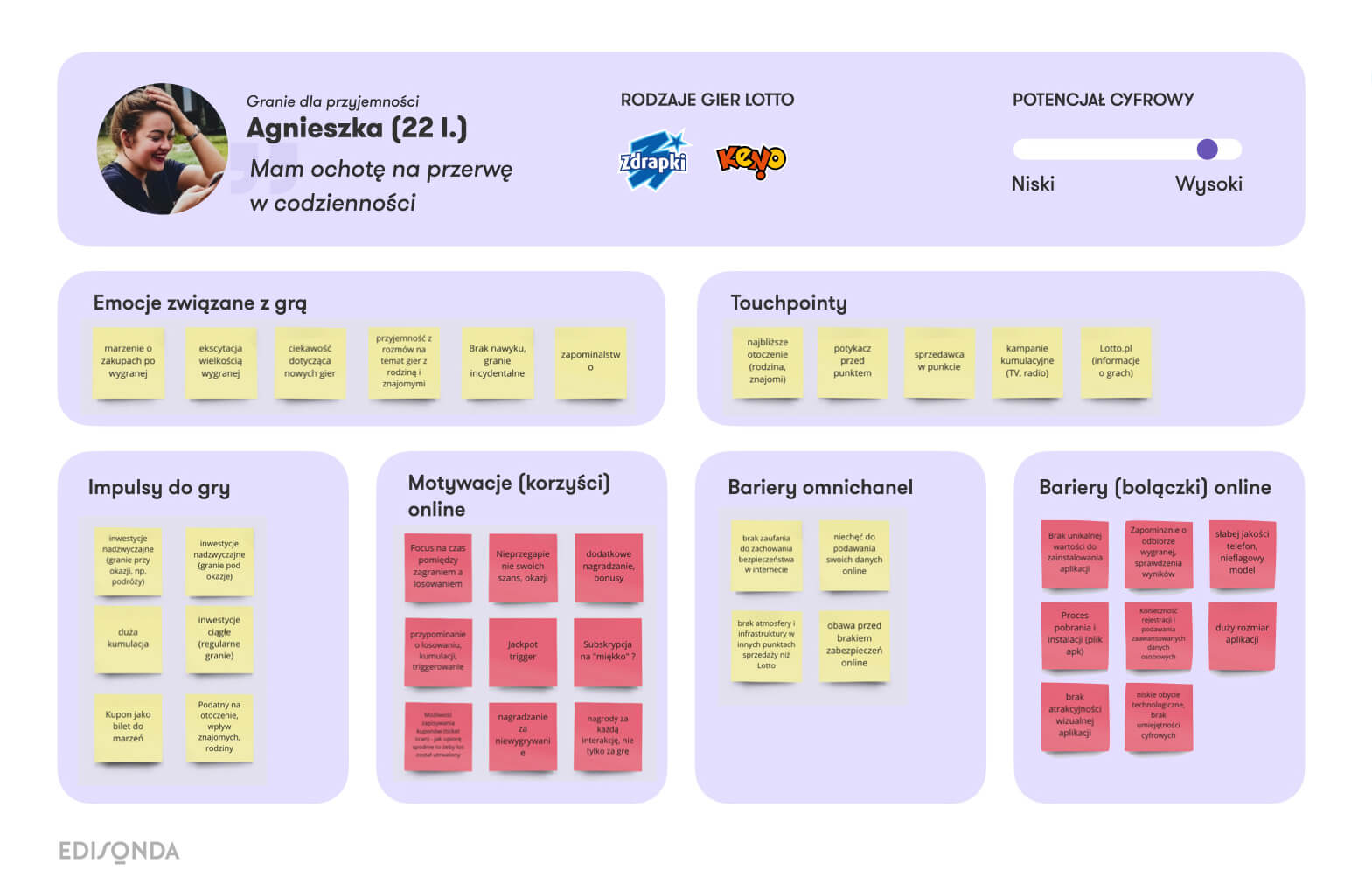
Learn from other players
Round 3: Which functionalities in the app are the most important?
- Why is there a wheel of fortune on the start page in the Danish lottery app, but a LOTTO ticket scanner in the UK app?
- Why can you only check the results of LOTTO draws in the German app?
Designing an application for a customer with no direct competition is usually a major challenge. On the one hand, this is an advantageous situation for the company, but on the other hand, it is difficult to convince users later on of completely new, unfamiliar features.
Therefore, an extremely helpful activity during the LOTTO project was a journey through foreign lottery applications and related applications from the broader entertainment industry.
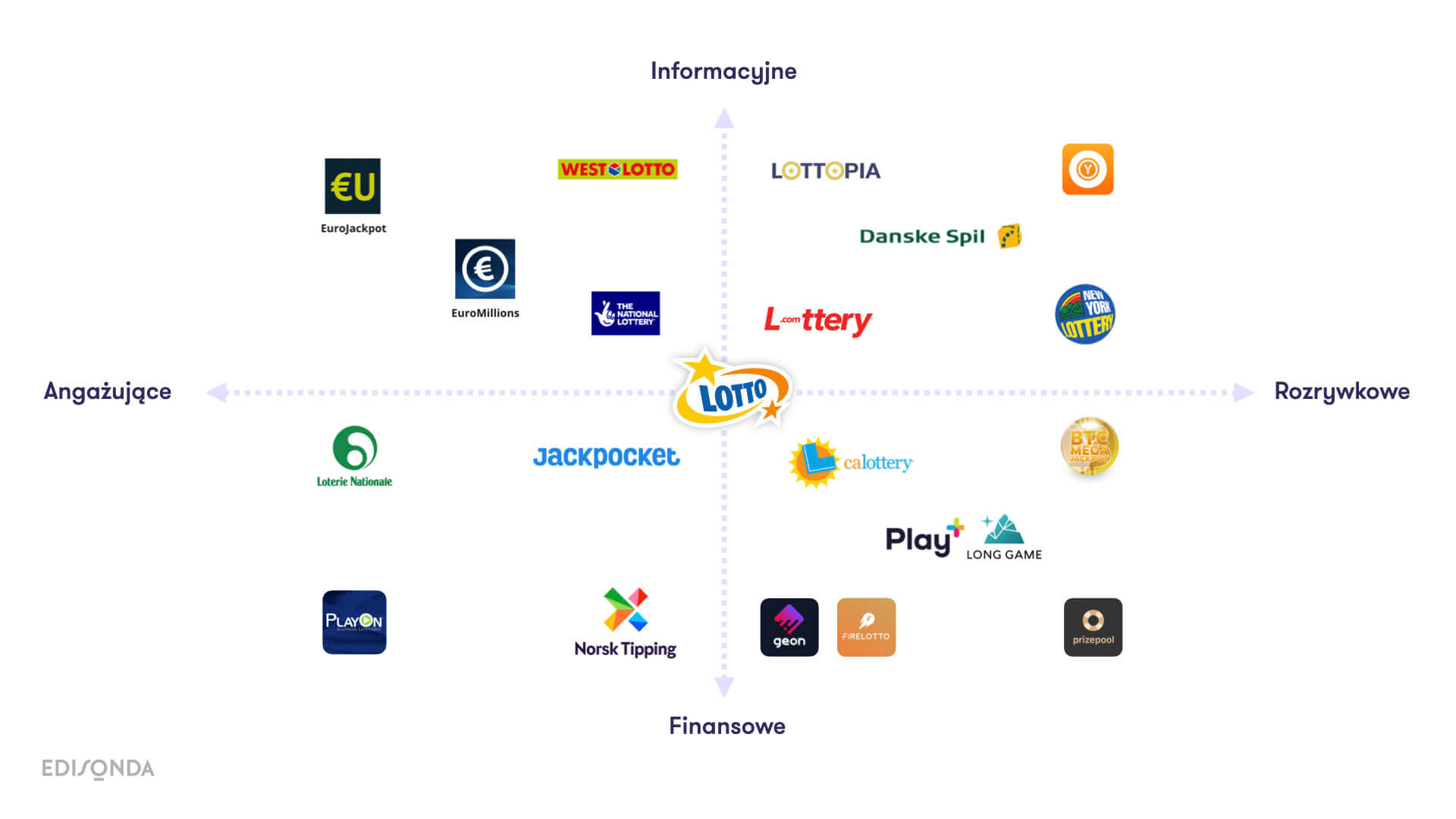
The lottery gaming system is regulated somewhat differently in different countries. This affects the range of functionality available online in individual online systems and mobile apps. However, the matrix of key functions of most lottery applications can be broken down into four dimensions, i.e.: information, loyalty, entertainment, and payment functions. In each country, the accents distributed across the app were slightly different, responding in part to the socio-demographic characteristics of players and cultural issues.
Having an overview of the possibilities and fitting in with LOTTO’s overall strategy and roadmap for the development of digital tools, we decided to experiment with different variations of the features and test them with users on an ongoing basis. From the beginning of the project, we had the feeling that the app should be as versatile and universal as possible (including different ranges of functions), but it must have its own atmosphere and theme.
Useful artefacts: Functional and graphical benchmarking – activities supporting the design work were a cross-sectional analysis of lottery and entertainment apps operating in the world and a mapping of the functions they offer. In addition, we looked at the graphical layer of the app, looking for our own visual style best suited to the world of LOTTO.
Play as a team
Round 4: Does a design sprint always look the same?
- When is it too late for user testing?
- What do we mean by multidisciplinary design team members?
- What is the role of the client’s working team?
- Many companies are working or are about to start working in agile methodologies, running design sprints, and other flexible forms of project management.
Many companies are working or are about to start working in agile methodologies, running design sprints, and other flexible forms of project management. Yes, these methodologies are becoming increasingly popular because they work and are effective. However, it is always worthwhile to experiment additionally and not stick to established frameworks.
Despite operating in a design sprint format, it is often the case that the UX Designer waits for the UX Researcher’s research insights and the UX Designer passes on his or her work to the UI Designer.
Of course, everyone is in ongoing contact. From the perspective of a project where every detail counts, always shorten the distance and mix the roles and competences in the team. There really is sometimes no need to refine mockups to so-called ‘pixel perfect’. It’s better to give space for UX and UI designers to work together and go back to the old method of paper and pencil, and only then translate the whole thing straight away into a graphic design ready for testing.
Do test results always have to be at the beginning, middle, or end of the design process? Or is it a better idea to divide the research budget into ten smaller iterations available for use at any time if the team feels it is just time to test part of the concept? It is useful to draw on the knowledge and skills of all team members on an ongoing basis, giving them the space to share insights and conclusions flexibly at any point in the project process.
Of course, it all depends on the format and schedule of the project you have agreed on with the client and the composition of the team. In the project for Totalizator Sportowy, we were fortunate that working with the client’s R&D team, we were responsible for the full design process of the initiative. Such projects, from our perspective, have a far better effect than splitting competences across too many subcontractors.

Iteration and ongoing checking of design concepts were key to the development of the application. The more opportunities to test assumptions (whether in the form of one-to-one working meetings or user testing), the better for the project.
Useful artefacts: Iterative design and research process – we conducted user testing iteratively, splitting the original research budget into smaller parts. This approach was much more efficient and allowed us to bypass many design misconceptions in time. In addition, we ‘bounced’ any design challenges off project team members and the client on an ongoing basis without any unnecessary paperwork.
Follow the rules and fair play
Round 5: Does the jackpot always have to shine?
- Let’s start from the beginning – what is gambling?
- Apart from the lack of dark patterns, what protects our players?
- Gambling is all games for money or other goods in which the outcome is decided by fate.

So you are gambling if there is a stake in the game and the possibility of winning, but especially when the outcome of the game does not depend on your skill or knowledge and you have no influence on it, i.e. when it is decided by chance.
Gambling is a form of fun, entertainment, but only available to adults. People take part in gambling to have fun, to feel the excitement of risk and uncertainty, and to hit their winnings. There are many reasons why people play. Some to win money, others for social purposes, entertainment or to kill time. However, the possibility of potential winnings, the element of surprise, the adrenaline, and the excitement that accompanies games can make this form of entertainment a serious problem for some players.
The need to experience strong tension, winning increasing the sense of one’s own power-control over the game and losses motivating to recover losses are factors that may push players to continue playing or to seek new challenges in this area.

The Responsible Gaming Programme has been carried out at Totalizator Sportowy since 2010. From the beginning, it has been built based on the best practices of the World Lottery Association and The European State Lotteries and Toto Association. Since 2013, the company has held the industry organisations’ Safe Gaming Certificates. The company not only provides millions of Poles with entertainment but above all wants to do it in a safe way. We had the same expectations from the LOTTO app.
The lottery business is close to the gaming industry. Psychologically, there are many similarities in gaming behaviour. You have probably heard about the UX ‘dark patterns’ and addictive practices found in mobile games or popular social media apps.
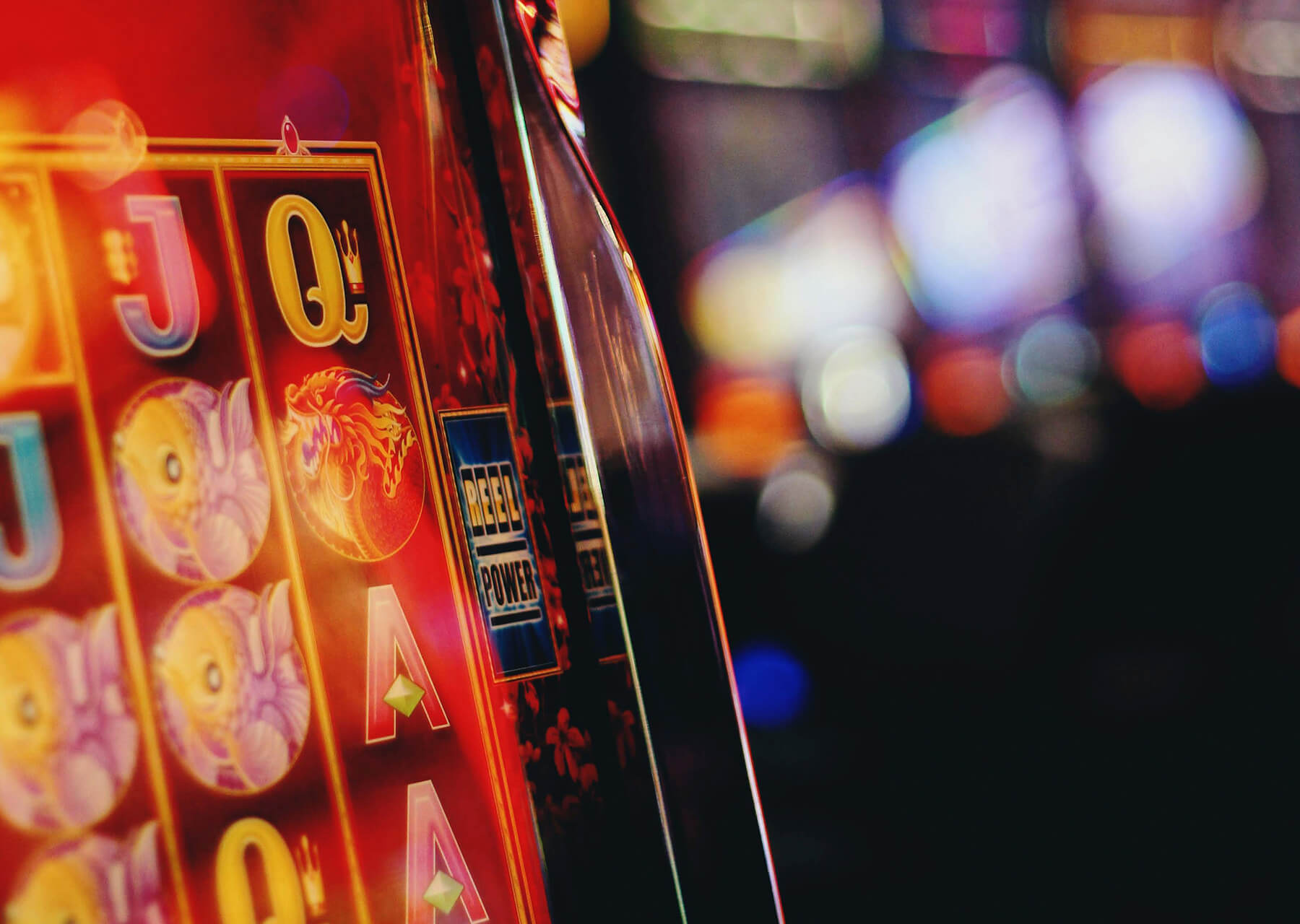
Designing the LOTTO app required an understanding of game mechanics. These mechanics in themselves cannot and do not have elements that intentionally tie the player to the game. However, it is easy to even unknowingly cross the line by adding an overly engaging message based on the player’s emotions. This is why, when creating the team for a project, we include industry experience from different areas of operation.
It is often the experience of the designer that influences the nature of the application and its final shape. Contrary to appearances, it is worthwhile to use the competencies of the team gained in other industries. From the perspective of creating the LOTTO app, it worked well for us to use the knowledge and design experience gained especially in the financial and e-commerce industries.
Have your own style
Round 6: How do graphics affect the perception of the app?
- How to create a consistent interface style for 10 different games that have their own distinct style?
- How to use animation to transfer the player experience from the collector’s office to the smartphone?
- How to support usability when creating attractive graphics and not “flow” into visual fireworks?
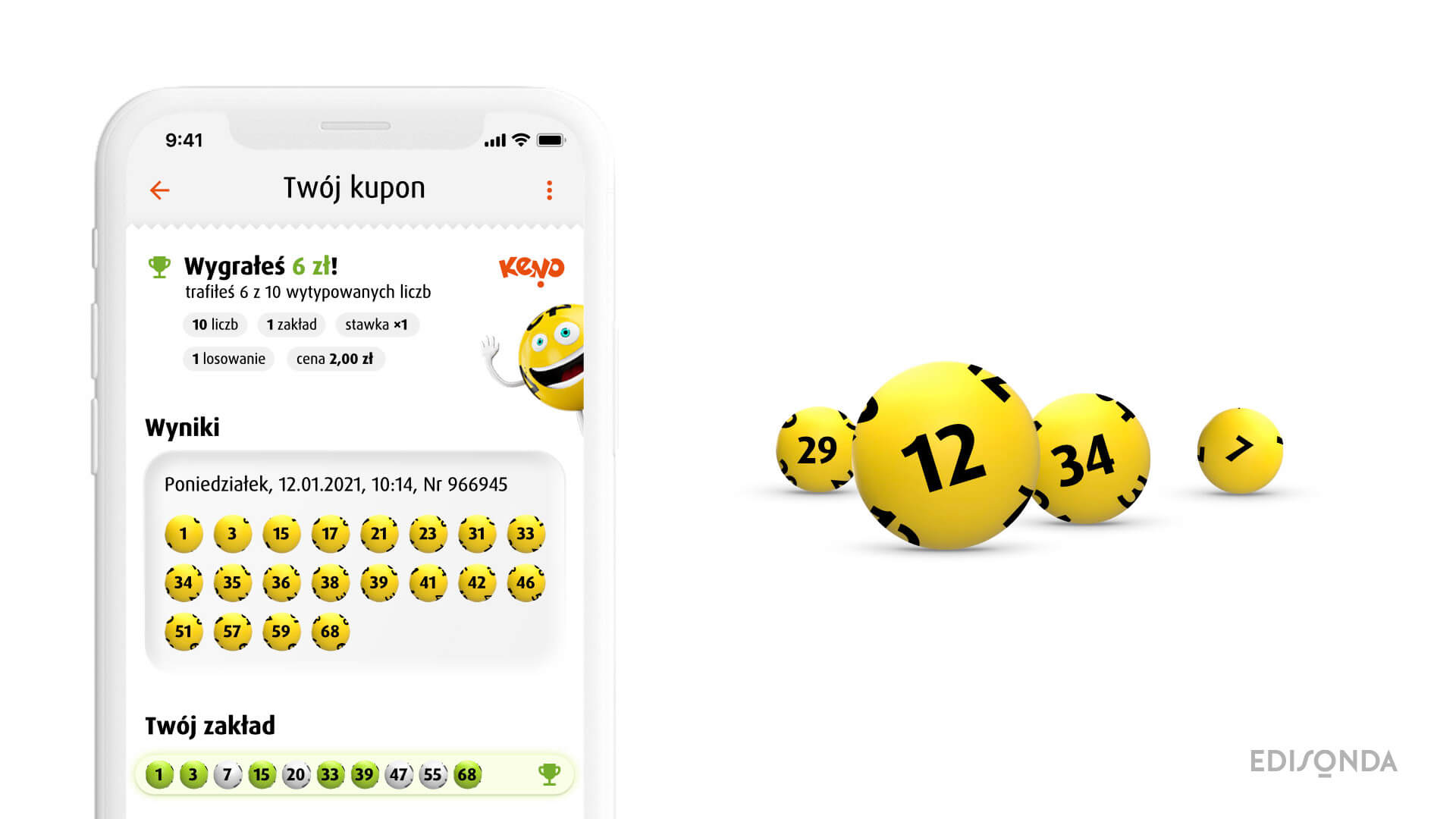
When choosing an interface style for the graphic concept of an application, it is useful to use relevant patterns and approach the subject strategically. The first clue is certainly the colourful, funfair style characteristic of number games. Colour, by the way, plays a more important role here, as it is this, in the form of a system of tints and shades, that will be used to distinguish contexts between the 10 different games. Each of these games is a separate sub-brand with its own distinct style and logo, yet they all have to use a consistent interface of a single application. So a lot depends on a well-planned system design with a UI library that takes into account the existence of multiple brands.

The second idea is to make use of stylistic trends: since our users will be people who have had a very real experience with LOTTO in a lottery outlet (or a slightly less real experience while watching a lottery draw on TV), let’s use neumorphism – an interface that reconciles the modernity of flat design with the skeuomorphic realism of lottery balls. This is perfect for adding depth to objects and positioning them in – admittedly flat – space.
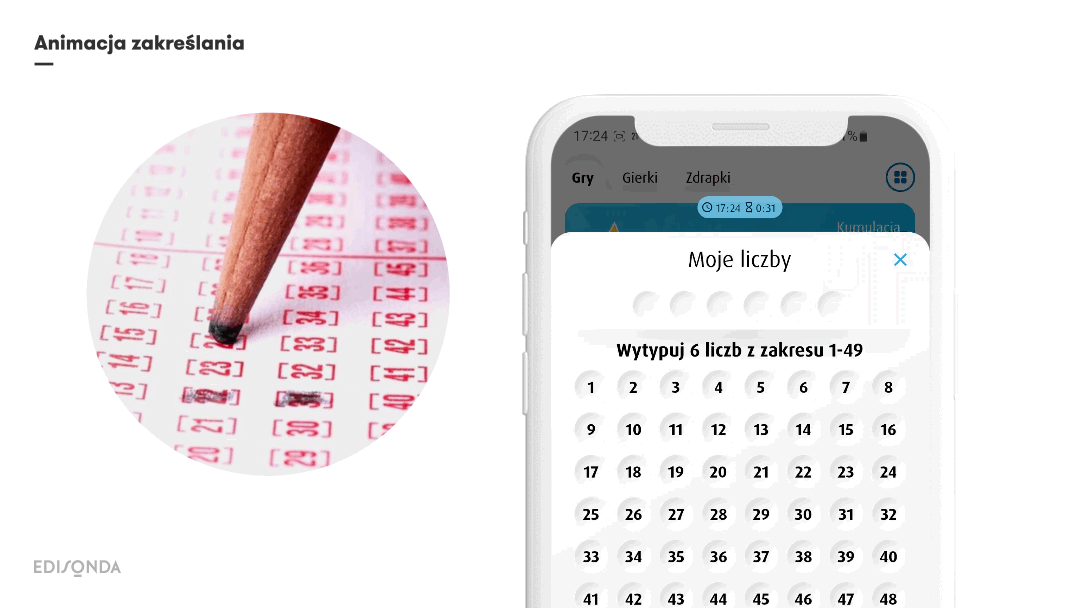
The same goes for animations – after all, we don’t want to take away players’ gaming pleasure just because they switch to a smartphone. We can translate the frail movement of lightweight balls lifted by compressed air or circling numbers with a pen into the animated language of the interface, creating a bridge between the offline and online worlds. Importantly, the aim of such treatments is not to have a ‘wow’ effect, but primarily to promote usability, as the player will find it easier to understand the mechanics of the app by connecting these visual connotations to something they already know.
It’s more than a game
Round 7: What will make players download apps?
- Why is checking a paper LOTTO coupon inconvenient?
- Does it make sense for the app to reflect the situation of the coupon being circled and why?
- Surely the balls in the app should look the same as in the draw machine?
Translating the gaming experience available from the web version of a website is not enough for the success of an app. A mobile digital experience can offer much more than an online game on a PC. The key questions we asked ourselves when designing the app were: why will players download the app to their phones? What will encourage them most to play on the LOTTO app?
It is too early to judge whether our assumptions have been successful. The app has only been on the market for a few months. However, it is not the function itself that is at stake here, as this may change even during the app’s development. However, it is important to continually ask ourselves what key value customers bring to having the app.
Increase the likelihood of winning
Round 8: Why do users like to complain?
- Where are my favourite figures written? Who designed this?
- It was great before. The 3.5.8 update has ruined everything
Customers don’t like change. They quickly get used to the current solutions. Omitting even the smallest function they know from the previous version of a service or application will provoke dissatisfaction and negative comments. It is impossible to predict and difficult to always design in the same way. The most important thing is to prepare customers for change and be ready for a negative wave of comments.
During the development of the application, we had no influence on its implementation. However, we remained in constant contact with the development team and were open to help and modifications to the project. Taking joint responsibility for the outcome of the work even after the completion of its stage is very important for the success of the app. Any implementation of a new feature will cause some waves of dissatisfaction. It is important to be confident in your assumptions and support users in accepting the change.
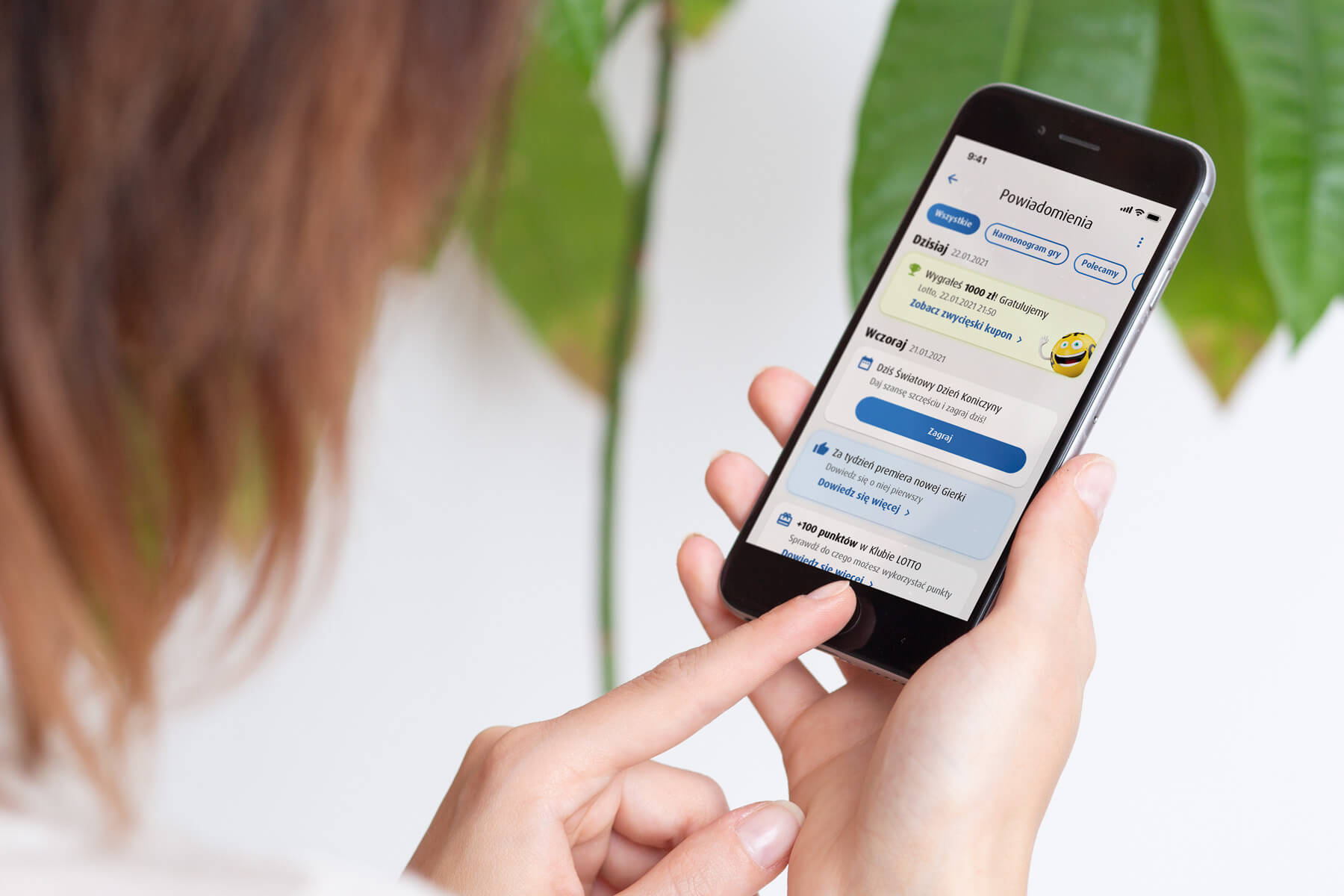
Don’t be afraid to play
Round 9: Why do we like to visit tried and tested sites?
- Why Google Material Design?
- What colour of LOTTO ball do players like best?
The experience of using the app and the web system should be similar for the user.
This consists of the UX and mechanics of the tools, but also the entire visual layer interacting with the user. The consistency of the graphical elements in the application ties the user to the company’s world. If these elements differ too much from each other, the player may have doubts as to whether they are in the right place. At the same time, this may cannibalise the different sales channels.
The answer to ensuring consistency across all of a company’s digital tools is to use a single design system. This goes a long way to building the customer experience. This is all the more important in companies that rely on ‘omnichannel’ service in both traditional points of sale and online. The user should feel a similar quality of experience in every contact with the company. When working on the LOTTO app, we assumed that the elements used in it should match the entire visual identity of the company.
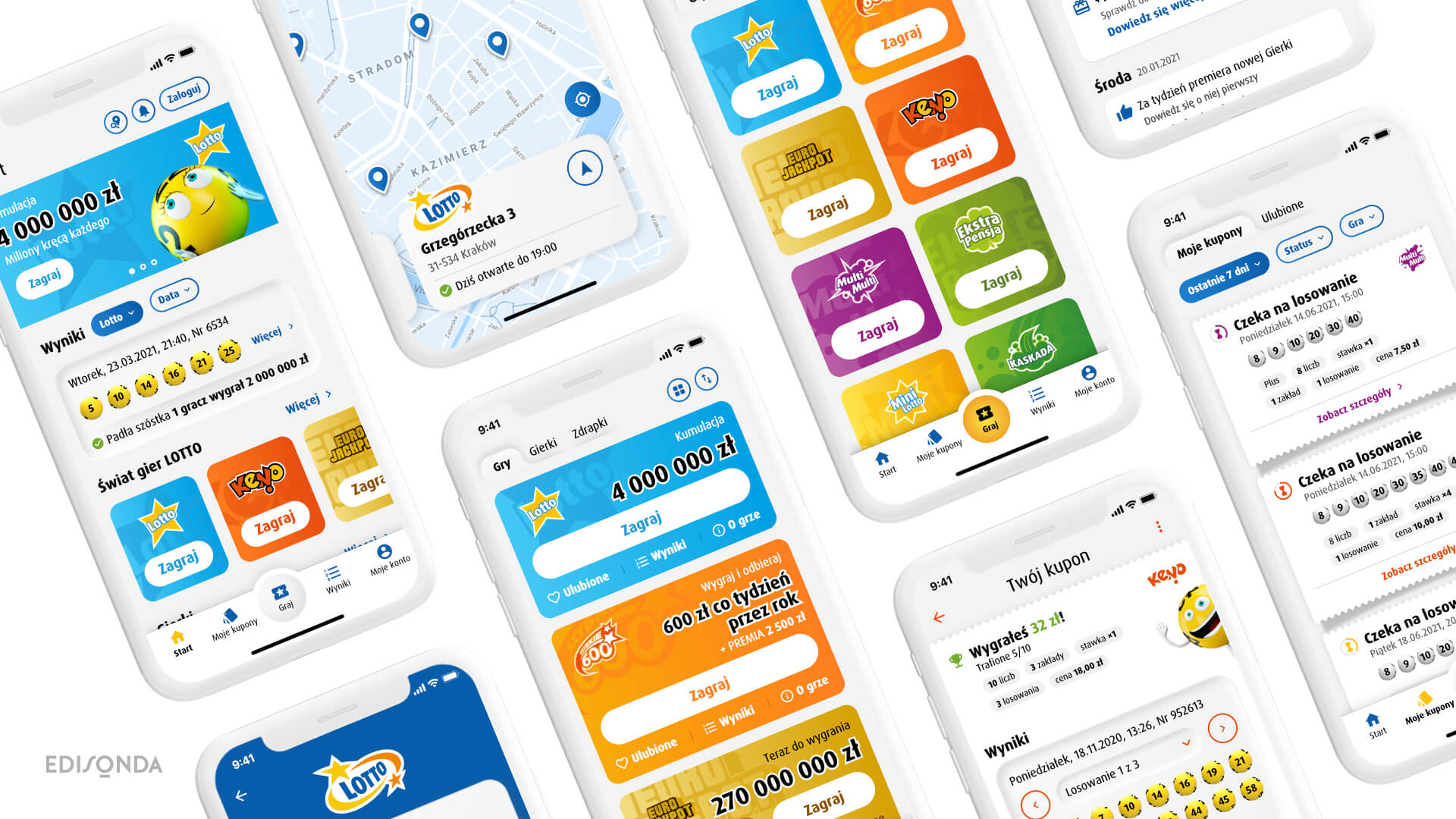
Useful artefacts:
Design system – a set of principles, tools, and ready-made components that facilitate the creation of new digital projects within a company (i.e. web systems and mobile applications, websites, etc.). The design system organises visual styles and the way content is presented so that it is consistent across all projects on which it is used. In this way, visually the brand remains consistent and the creation of new digital projects is simplified due to the ability to use pre-prepared solutions.
Bonus
Round 10: Where do we go from here?
- What does the North Star show?
- How to approach the development of indicators?
The success of an app can be measured by various indicators. A very basic, though often illusory, indicator is the rating of the app in the system shops (Apple Store and Google Play). It is worth developing an internal set of indicators to monitor customer satisfaction with the use of the app.
The success of an app can be measured by various indicators. A very basic, though often illusory, indicator is the rating of the app in the system shops (Apple Store and Google Play). It is worth developing an internal set of indicators to monitor customer satisfaction with the use of the app. This allows for constant monitoring and continuous optimisation. Of course, it is worth using the benefits of web analytics for applications. However, it is worth looking for other, more universal indicators.
During the project work, we developed indicators that are important from the point of view of both clients and the company. One of my favourites is the one asking: how many users of the app will put it on the first screen of their smartphone? I hope that as the app develops, this percentage will increase.
Developing and improving apps is a never-ending process. All the more so as the lottery games market is growing extremely rapidly and becoming increasingly digitalised. It is getting closer and closer to the related market of sports betting services and applications. The portfolio of LOTTO-branded games is expanding. Online, it is possible to play not only draw-based games but also Gierki, a virtual equivalent of the well-known traditional scratch cards. The speed of digitisation taking place in the lottery market is likely to generate increasingly sophisticated and attractive solutions for players. We will continue to watch this industry with curiosity and cheer its development.
